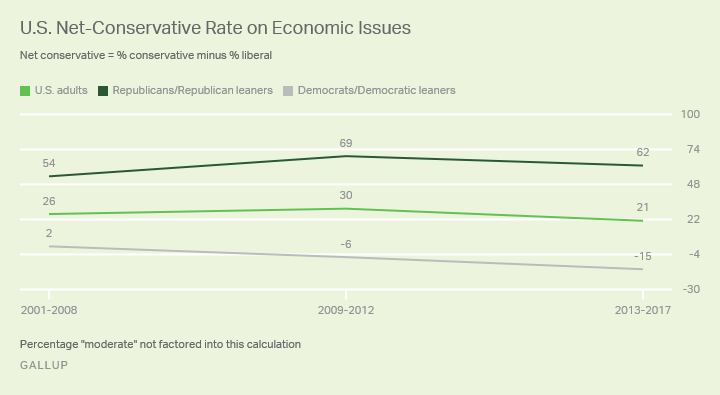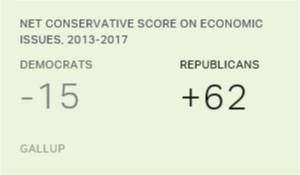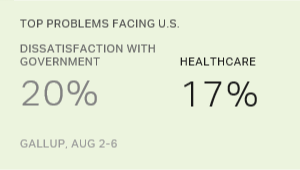Story Highlights
- Democrats' economic views have shifted from net conservative to net liberal
- Still, almost half of Democrats identify as moderate on economic views
- Republicans more conservative on economic issues than during Bush years
WASHINGTON, D.C. -- Americans' economic ideology has tilted conservative over the past two decades, with only modest variation in conservatives' lead over liberals. However, changes have been happening beneath the surface, with slightly more Republicans identifying as economically conservative than did so during the George W. Bush years and Democrats tugging the national needle a bit left as they have grown more economically liberal.

This partisan divergence suggests that the White House faces a more challenging political landscape than did the last Republican president in terms of bringing Republicans and Democrats together over tax reform and other economic policies.
Gallup asks U.S. adults each year to describe their social and economic views on a five-point scale, from "very conservative" to "very liberal," with "moderate" as the midpoint. The net conservative percentage is the difference between those describing their views as "conservative" or "very conservative" minus the percentage saying "liberal" or "very liberal."
In terms of their economic philosophy, Republicans' and Democrats' views have changed over time, but in steps rather than gradually -- resulting in three distinct public opinion phases since Gallup began tracking this annually in 2001.
The first phase spanned George W. Bush's presidency, from 2001 to 2008. Over those eight years, Republicans' and Democrats' economic stances were largely steady, with Republicans' net conservatism averaging +54 and Democrats' averaging +2.
At the start of Barack Obama's presidency in 2009, Republicans took an abrupt turn to the right, with their net conservativism on economic issues averaging +69 from 2009 to 2012. Meanwhile, Democrats' views became slightly more liberal than conservative, averaging -6.
In 2013, Republicans' economic conservatism softened a bit, while Democrats' economic liberalism grew further. As a result, from 2013 to 2017, net economic conservatism has averaged +62 among Republicans and -15 among Democrats.
| 2001-2008 | 2009-2012 | 2013-2017 | ||||||||||||||||||||||||||||||||||||||||||||||||||||||||||||||||||||||||||||||||||||||||||||||||||
|---|---|---|---|---|---|---|---|---|---|---|---|---|---|---|---|---|---|---|---|---|---|---|---|---|---|---|---|---|---|---|---|---|---|---|---|---|---|---|---|---|---|---|---|---|---|---|---|---|---|---|---|---|---|---|---|---|---|---|---|---|---|---|---|---|---|---|---|---|---|---|---|---|---|---|---|---|---|---|---|---|---|---|---|---|---|---|---|---|---|---|---|---|---|---|---|---|---|---|---|---|
| % | % | % | ||||||||||||||||||||||||||||||||||||||||||||||||||||||||||||||||||||||||||||||||||||||||||||||||||
| Democrats/Democratic leaners | ||||||||||||||||||||||||||||||||||||||||||||||||||||||||||||||||||||||||||||||||||||||||||||||||||||
| Conservative | 27 | 25 | 18 | |||||||||||||||||||||||||||||||||||||||||||||||||||||||||||||||||||||||||||||||||||||||||||||||||
| Moderate | 45 | 43 | 46 | |||||||||||||||||||||||||||||||||||||||||||||||||||||||||||||||||||||||||||||||||||||||||||||||||
| Liberal | 25 | 31 | 33 | |||||||||||||||||||||||||||||||||||||||||||||||||||||||||||||||||||||||||||||||||||||||||||||||||
| NET CONSERVATIVE | +2 | -6 | -15 | |||||||||||||||||||||||||||||||||||||||||||||||||||||||||||||||||||||||||||||||||||||||||||||||||
| Republicans/Republican leaners | ||||||||||||||||||||||||||||||||||||||||||||||||||||||||||||||||||||||||||||||||||||||||||||||||||||
| Conservative | 61 | 74 | 68 | |||||||||||||||||||||||||||||||||||||||||||||||||||||||||||||||||||||||||||||||||||||||||||||||||
| Moderate | 31 | 19 | 25 | |||||||||||||||||||||||||||||||||||||||||||||||||||||||||||||||||||||||||||||||||||||||||||||||||
| Liberal | 7 | 5 | 6 | |||||||||||||||||||||||||||||||||||||||||||||||||||||||||||||||||||||||||||||||||||||||||||||||||
| NET CONSERVATIVE | +54 | +69 | +62 | |||||||||||||||||||||||||||||||||||||||||||||||||||||||||||||||||||||||||||||||||||||||||||||||||
| Gallup | ||||||||||||||||||||||||||||||||||||||||||||||||||||||||||||||||||||||||||||||||||||||||||||||||||||
Shifts in Economic Views Largely Uniform Within Parties
Using the same three time periods to evaluate the demographic trends in economic views within each party, it is apparent that increased economic conservatism among Republicans has mostly occurred across the board, with similar increases seen by gender, age and race.
Only on the basis of income is there a difference. Lower-income Republicans have become slightly less conservative on economic issues since the Bush years, while middle-income and more affluent Republicans have grown more conservative.
More specifically, net conservatism among Republicans with an annual household income of less than $30,000 has fallen to +37 in recent years, from +42 during the Bush era. Meanwhile, net conservatism among Republicans in middle-income households has risen to +66 from +53. Republicans in households earning $75,000 or more are the most economically conservative of all, with an average net-conservative score of +70 since 2013, up from +64 from 2001 to 2008.
Similarly, the shift toward economic liberalism among Democrats has occurred among most major demographic subgroups within the party. However, it has been a bit less pronounced among younger Democrats -- who already tilted economically liberal from 2001 to 2008 -- than among those aged 35 and older.
See the tables at the end of this article for net-conservative scores by subgroup within each partisan group.
Bottom Line
While more Americans still identify as conservative than as liberal on economic issues, the conservative edge has narrowed after widening slightly during the Obama years. Democrats have become significantly more liberal on economic issues, while Republicans have grown more economically conservative.
As previously reported, Americans' ideology on social views has shifted over the past two decades, with self-identified social liberals nearly catching up to social conservatives, largely due to burgeoning social liberalism among Democrats.
Unlike Democrats' increasing social liberalism -- which has been most pronounced among older, white, female and college-educated Democrats -- the increase in Democrats' economic liberalism has been more universal within the party. This may help explain what holds Democrats together as a party, even as certain subgroups differ on social issues.

Subscribe to our online platform to access nearly a century of data.
Gallup Analytics lets you search, compare and export data to enhance your research.
Survey Methods
Results are based on aggregated data from Gallup's annual Values and Beliefs poll, conducted among U.S. adults aged 18 and older, living in all 50 states and the District of Columbia.
The aggregated sample for 2001-2008 contains 8,056 adults and has a margin of sampling error of ±1 percentage point or less at the 95% confidence level. The aggregated sample for 2009-2012 contains 4,086 adults and has a margin of sampling error of ±2 percentage points or less at the 95% confidence level. The aggregated sample for 2013-2017 contains 5,623 adults and has a margin of sampling error of ±2 percentage points or less at the 95% confidence level.
Results based on Republicans/Republican leaners and Democrats/Democratic leaners have margins of sampling error one point higher than the national adult sample for each aggregate time period, due to the lower sample sizes of these subgroups. In the most recent aggregate, for 2013-2017, there were 2,523 Republicans/Republican leaners and 2,528 Democrats/Democratic leaners, with an associated margin of sampling error for each of ±3 percentage points or less at the 95% confidence level.
All reported margins of sampling error include computed design effects for weighting.
| 2001-2008 | 2009-2012 | 2013-2017 | Change since 2001-2008 | |||||||||||||||||||||||||||||||||||||||||||||||||||||||||||||||||||||||||||||||||||||||||||||||||
|---|---|---|---|---|---|---|---|---|---|---|---|---|---|---|---|---|---|---|---|---|---|---|---|---|---|---|---|---|---|---|---|---|---|---|---|---|---|---|---|---|---|---|---|---|---|---|---|---|---|---|---|---|---|---|---|---|---|---|---|---|---|---|---|---|---|---|---|---|---|---|---|---|---|---|---|---|---|---|---|---|---|---|---|---|---|---|---|---|---|---|---|---|---|---|---|---|---|---|---|---|
| Gender | ||||||||||||||||||||||||||||||||||||||||||||||||||||||||||||||||||||||||||||||||||||||||||||||||||||
| Men | +2 | -6 | -16 | -18 | ||||||||||||||||||||||||||||||||||||||||||||||||||||||||||||||||||||||||||||||||||||||||||||||||
| Women | +3 | -6 | -15 | -18 | ||||||||||||||||||||||||||||||||||||||||||||||||||||||||||||||||||||||||||||||||||||||||||||||||
| Age | ||||||||||||||||||||||||||||||||||||||||||||||||||||||||||||||||||||||||||||||||||||||||||||||||||||
| 18-34 | -10 | -17 | -21 | -11 | ||||||||||||||||||||||||||||||||||||||||||||||||||||||||||||||||||||||||||||||||||||||||||||||||
| 35-54 | +4 | -4 | -15 | -19 | ||||||||||||||||||||||||||||||||||||||||||||||||||||||||||||||||||||||||||||||||||||||||||||||||
| 55+ | +12 | +1 | -10 | -22 | ||||||||||||||||||||||||||||||||||||||||||||||||||||||||||||||||||||||||||||||||||||||||||||||||
| Race | ||||||||||||||||||||||||||||||||||||||||||||||||||||||||||||||||||||||||||||||||||||||||||||||||||||
| Non-Hispanic whites | +1 | -10 | -17 | -18 | ||||||||||||||||||||||||||||||||||||||||||||||||||||||||||||||||||||||||||||||||||||||||||||||||
| Non-Hispanic blacks | +8 | +4 | -14 | -22 | ||||||||||||||||||||||||||||||||||||||||||||||||||||||||||||||||||||||||||||||||||||||||||||||||
| Hispanics | +8 | +9 | -6 | -14 | ||||||||||||||||||||||||||||||||||||||||||||||||||||||||||||||||||||||||||||||||||||||||||||||||
| Income | ||||||||||||||||||||||||||||||||||||||||||||||||||||||||||||||||||||||||||||||||||||||||||||||||||||
| <$30,000 | +8 | +2 | -9 | -17 | ||||||||||||||||||||||||||||||||||||||||||||||||||||||||||||||||||||||||||||||||||||||||||||||||
| $30,000-$74,999 | +2 | -10 | -13 | -15 | ||||||||||||||||||||||||||||||||||||||||||||||||||||||||||||||||||||||||||||||||||||||||||||||||
| $75,000+ | -7 | -9 | -25 | -18 | ||||||||||||||||||||||||||||||||||||||||||||||||||||||||||||||||||||||||||||||||||||||||||||||||
| Percentage "moderate" not factored into this calculation | ||||||||||||||||||||||||||||||||||||||||||||||||||||||||||||||||||||||||||||||||||||||||||||||||||||
| Gallup | ||||||||||||||||||||||||||||||||||||||||||||||||||||||||||||||||||||||||||||||||||||||||||||||||||||
| 2001-2008 | 2009-2012 | 2013-2017 | Change since 2001-2008 | |||||||||||||||||||||||||||||||||||||||||||||||||||||||||||||||||||||||||||||||||||||||||||||||||
|---|---|---|---|---|---|---|---|---|---|---|---|---|---|---|---|---|---|---|---|---|---|---|---|---|---|---|---|---|---|---|---|---|---|---|---|---|---|---|---|---|---|---|---|---|---|---|---|---|---|---|---|---|---|---|---|---|---|---|---|---|---|---|---|---|---|---|---|---|---|---|---|---|---|---|---|---|---|---|---|---|---|---|---|---|---|---|---|---|---|---|---|---|---|---|---|---|---|---|---|---|
| Gender | ||||||||||||||||||||||||||||||||||||||||||||||||||||||||||||||||||||||||||||||||||||||||||||||||||||
| Men | +57 | +72 | +65 | +8 | ||||||||||||||||||||||||||||||||||||||||||||||||||||||||||||||||||||||||||||||||||||||||||||||||
| Women | +50 | +66 | +58 | +8 | ||||||||||||||||||||||||||||||||||||||||||||||||||||||||||||||||||||||||||||||||||||||||||||||||
| Age | ||||||||||||||||||||||||||||||||||||||||||||||||||||||||||||||||||||||||||||||||||||||||||||||||||||
| 18-34 | +41 | +57 | +49 | +8 | ||||||||||||||||||||||||||||||||||||||||||||||||||||||||||||||||||||||||||||||||||||||||||||||||
| 35-54 | +57 | +72 | +63 | +6 | ||||||||||||||||||||||||||||||||||||||||||||||||||||||||||||||||||||||||||||||||||||||||||||||||
| 55+ | +62 | +73 | +67 | +5 | ||||||||||||||||||||||||||||||||||||||||||||||||||||||||||||||||||||||||||||||||||||||||||||||||
| Race | ||||||||||||||||||||||||||||||||||||||||||||||||||||||||||||||||||||||||||||||||||||||||||||||||||||
| Whites | +57 | +71 | +66 | +9 | ||||||||||||||||||||||||||||||||||||||||||||||||||||||||||||||||||||||||||||||||||||||||||||||||
| Nonwhites | +30 | +51 | +40 | +10 | ||||||||||||||||||||||||||||||||||||||||||||||||||||||||||||||||||||||||||||||||||||||||||||||||
| Income | ||||||||||||||||||||||||||||||||||||||||||||||||||||||||||||||||||||||||||||||||||||||||||||||||||||
| <$30,000 | +42 | +65 | +37 | -5 | ||||||||||||||||||||||||||||||||||||||||||||||||||||||||||||||||||||||||||||||||||||||||||||||||
| $30,000-$74,999 | +53 | +66 | +66 | +13 | ||||||||||||||||||||||||||||||||||||||||||||||||||||||||||||||||||||||||||||||||||||||||||||||||
| $75,000+ | +64 | +76 | +70 | +6 | ||||||||||||||||||||||||||||||||||||||||||||||||||||||||||||||||||||||||||||||||||||||||||||||||
| Percentage "moderate" not factored into this calculation | ||||||||||||||||||||||||||||||||||||||||||||||||||||||||||||||||||||||||||||||||||||||||||||||||||||
| Gallup | ||||||||||||||||||||||||||||||||||||||||||||||||||||||||||||||||||||||||||||||||||||||||||||||||||||




